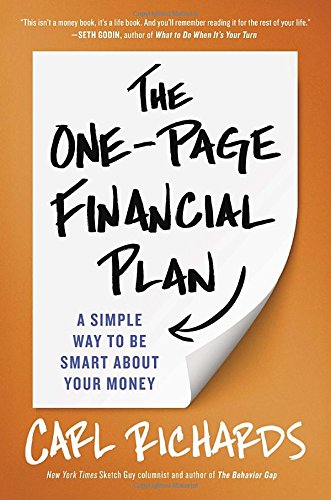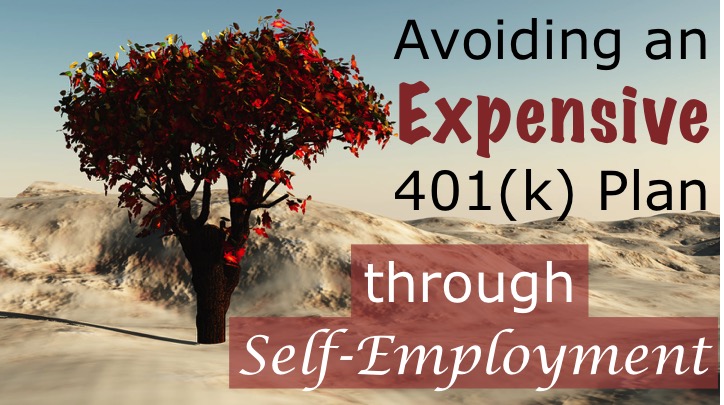Reflections on The One-Page Financial Plan
I recently read The One-Page Financial Plan: A Simple Way to Be Smart about Your Money by Carl Richards (affiliate link – thanks for using!). It’s a quick read (I think it took me approximately 3 hours total) and liberally sprinkled with the delightful sketches that Carl Richards is known for.
The purpose of the book is to walk the reader through a generic version of the financial planning process that one would go through with Carl Richards or a similar financial planner.
 In Part 1, “Discovery,” the reader identifies values, sets high-level financial goals, and creates a balance sheet.
In Part 1, “Discovery,” the reader identifies values, sets high-level financial goals, and creates a balance sheet.
Part 2, “Spending and Saving,” reframes budgeting as becoming aware of your spending and gives some tips to increase your personal savings rate (as well as why to do so).
Part 3, “Investing,” covers life insurance, paying down debt (and decisions around mortgages), and passive investing.
In Part 4, “Strategies for Avoiding the Big Mistake,” Richards suggests hiring a fee-only financial planner and reiterates the importance of sticking to your financial plan over the long-term.
This book covered very familiar territory for me as it has nearly the same outline as my comprehensive personal finance seminar for stipend-receiving graduate students, “The Graduate Student’s Guide to Personal Finance.” (That definitely reinforces that I’m on the right track with that seminar!) In fact, because Richards includes so many personal stories and client conversations as examples in the book, I’d say the topics are covered in about the same degree of depth in the book as in my seminar.
The best description for the book appears in the subtitle: simple. It’s a fast, easy-to-understand read, and at first I was underwhelmed. One of my purposes in reading books like this is to expand my own knowledge of personal finance, and this book didn’t do that. I can’t say I learned anything new aside from Richards’ particular take on these topics (pretty conservative about investing and house-buying after being burned in the Great Recession!). Kyle actually started reading the book before I did, and he put it down after a few chapters, saying “This is all common sense stuff.” (Well, common sense for him; I had to study for many years to internalize these principles!)
But after finishing the book and taking a step back, I acknowledge that simple does not mean inferior or lacking. When I looked at this book/planning process as a person who co-manages our household finances, I realized that it’s exactly what I need right now. What good is it to learn a bunch of fancy, complicated strategies when you haven’t taken the simple first steps?
I’ve been lamenting to Kyle recently that we’ve allowed a certain amount of sprawl in our finances. We have money here and there doing this and that, and we’re behind on making some changes we should have when DPR was born. When we were in grad school, we were much more clear about our goals than we are now that we have more money to play with. We do need a one-page financial plan that unifies all these disparate parts.
In the introduction, Richards describes creating a one-page financial plan with his wife. “I noticed a Sharpie on my desk and saw card stock in the printer, so I pulled them out and just wrote down the three or four things that were really important to us. The first answered the question “Why?–Why is money really important to us?” It served as a kind of statement of our values, something that would remind us why we were working hard and saving money. The remaining three were specific things that we needed to do to reach our major financial goals.”
I’d like to keep things simple in our finances. After all, it’s better to enact a simple plan than to generate a complex, fully optimized one that you never actually follow through on. More on implementing a one-page financial plan to come!
Have you read The One-Page Financial Plan and if so what did you think of it? Have you created a simple statement of your values and goals?
Filed under: books · Tags: financial planning

 How to Invest without a Financial Advisor
How to Invest without a Financial Advisor Financial Heroes or Financial Zeros?
Financial Heroes or Financial Zeros? First Job Problems: Which Health Insurance Plan Should I Choose?
First Job Problems: Which Health Insurance Plan Should I Choose? Avoiding an Expensive 401(k) Plan through Self-Employment
Avoiding an Expensive 401(k) Plan through Self-Employment

